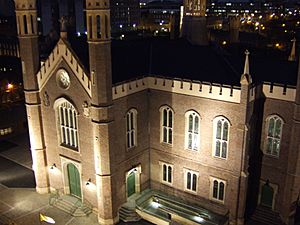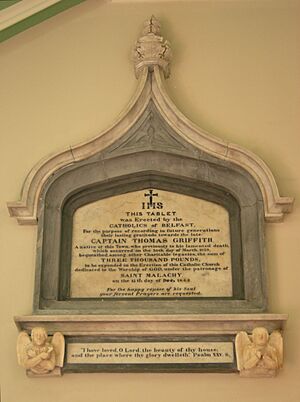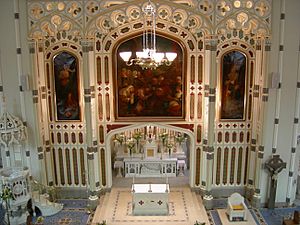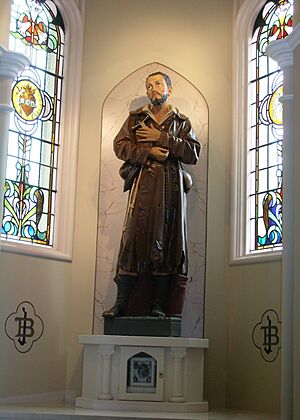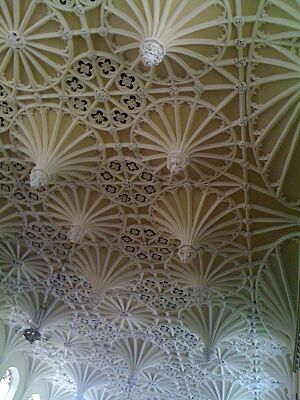St Malachy's Church, Belfast facts for kids
Saint Malachy's Church is a beautiful Catholic church located in Belfast, Northern Ireland. You can find it on Alfred Street, not far from Belfast City Hall. This church is actually much older than the City Hall, built over 60 years before it!
Saint Malachy's is a very important place for the local community. It is part of the Saint Malachy's parish, which is one of 88 parishes in the Diocese of Down and Connor. It is the second oldest Catholic church in Belfast that has been used continuously. While St Mary's Church, Belfast is the oldest, both St Mary's and St Patrick's Church, Belfast have been rebuilt a lot.
In the beginning, priests from St Mary's Church, Belfast looked after Saint Malachy's. Then, in 1866, the Parish of Saint Malachy was created. Father Geoffrey Brennan became its first leader. Later, in 1909, Father Daniel McCashin became the first official parish priest.
Contents
The Church's Story
For many years in the 1830s, the Bishop of Down and Connor, Dr Cornelius Denvir, wanted to build a third church. This was because more and more Catholic people were moving to Belfast. They needed more places to worship.
A kind Protestant merchant named Mr. Adam McClean owned a large area of land. He offered a good spot for the church near Donegall Square South. On May 1, 1839, a lease was signed for the land on Alfred Street. Mr. McClean even gave one part of the land as a gift!
The foundation stone for Saint Malachy's Church was laid on November 3, 1841. This day is special because it is the feast day of Saint Malachy. On December 15, 1844, Dr William Crolly, who was the Archbishop of Armagh, officially opened the building. Dr. Crolly used to be a bishop in the Down and Connor area.
Saint Malachy's was first planned to be the main church, or cathedral, for the Diocese of Down and Connor. However, because of money problems, a smaller church was built instead. Even so, it is still seen as one of the best examples of Tudor Revival style churches in Ireland.
Inside the Church
The church was designed by Thomas Jackson from Waterford. Its style looks like churches from the Tudor period in England. The builder who worked on the inside was Peter Lundy.
The church has a cross shape. It is 113 feet long, 52 feet wide, and 40 feet high. The original main altar, pulpit, and altar rails were made of Irish oak wood. But in 1926, during a renovation, they were replaced with marble. Only the canopy over the pulpit remains from the original design. It was painted white to match the new marble.
The floor in the sanctuary area is a beautiful mosaic, also from the 1926 renovation. Its main color is blue. At the front of the altar, you can see a picture of a pelican. This bird is a common Christian symbol for sacrifice. This amazing floor work was done by Ludwig Oppenheimer's studio in Manchester.
Saint Malachy's is most famous for its amazing fan-vaulted ceiling. It looks like the ceiling in the Henry VII Chapel at Westminster Abbey. Sir Charles Brett once said it looks "creamy, lacy and frothy" like a wedding cake turned inside out!
There are two smaller altars on the sides of the church. One is for Saint Joseph, and the other is for the Blessed Virgin Mary. The church also has statues of many saints, including the Sacred Heart of Jesus, Saint Francis of Assisi, Saint Anthony of Padua, Saint Thérèse of Lisieux, Saint Philomena, Saint Malachy himself, and Saint Benedict Joseph Labre. Saint Benedict Joseph Labre was known as "The Ragged Saint" in Belfast and across Ireland.
During World War II
During the Second World War, the German Air Force, called the Luftwaffe, bombed Belfast several times. On Easter Tuesday, April 15, 1941, a bomb landed right in front of Saint Malachy's Church. Luckily, it did not damage the church's main structure. However, many of its windows were blown in.
Another bomb landed nearby at the Gasworks. This explosion created a huge vacuum, which pulled out the rest of the windows. The original Irish oak window frames were completely destroyed. Because it was wartime, new oak frames could not be found. So, the windows were replaced with concrete frames.
Over 60 years, these concrete frames caused more damage than the bombs. They slowly destroyed the handmade bricks around them. By the time the church was restored, over 80,000 bricks needed to be replaced! Even with all this damage, the church stayed open during the war. Work was done in stages, sometimes with half the building closed off.
Modern Restoration
From the early 1980s, the area around Saint Malachy's was greatly redeveloped. This, along with the church's age, caused its brickwork to get worse. So, a big restoration project began in January 2008. It was finished in 2009 and cost £3,500,000. The inside of the church was also restored.
Beautiful patterns painted around the sanctuary, which had been covered up in the 1950s, were brought back. The altar rails and the detailed mosaic floor were also repaired. The church was officially reopened and the new altar was dedicated on March 29, 2009. Bishop Dr Noel Treanor led the special Mass.
This was the first time Saint Malachy's had been closed for a long time since it opened in 1844. While the church was being restored, weddings and funeral Masses were held in other nearby churches.
- Sunday Masses are: Vigil (Saturday) 6pm; 10.30am.
- Weekday Masses are at 1pm on Monday, Tuesday, Thursday, Friday.
- There is no Mass on Wednesday.
- Confessions are from 5.15 to 5.45pm each Saturday.
The Great Bell
Saint Malachy's Church is home to the largest bell in Belfast! Long ago, there was a whiskey distillery near the church. The owners complained that the loud sound of the bell was messing up their whiskey-making process.
Many people thought the bell was removed, but it wasn't! Instead, it was wrapped in felt to make its sound softer. However, by the time the church was restored in 2008–2009, the felt had worn away. Now, the full, loud sound of the bell can be heard at least three times every day!
Awards and Recognition
Since the church reopened in 2009, its restoration work has received many compliments and awards. These awards came from groups in Northern Ireland, the United Kingdom, and the Republic of Ireland. Some of the awards include:
- The Aisling Award 2009 for Belfast Brand.
- The Royal Institution of Chartered Surveyors Award 2010 for Building Conservation.
- The Royal Institution of Chartered Surveyors Award 2010 for Project of the Year.
- The Royal Institute of British Architects Award 2010.
- The Civic Trust Award 2010.
- The Royal Society of Ulster Architects Conservation Award 2010.
- The Irish Georgian Society Award 2010.


